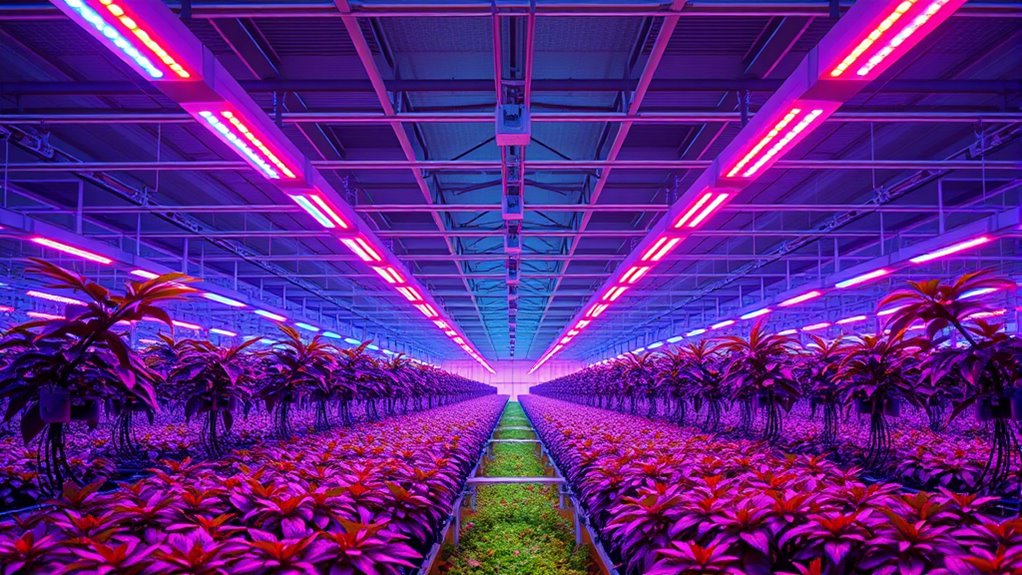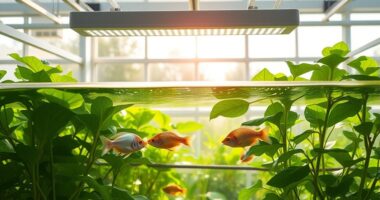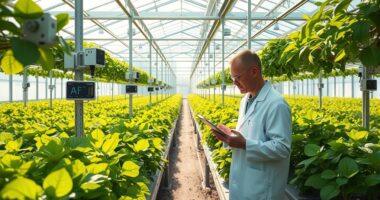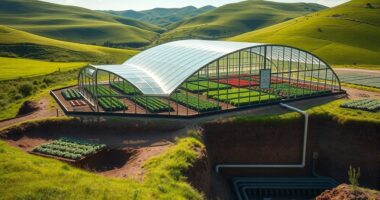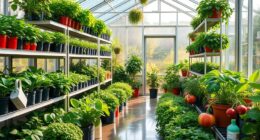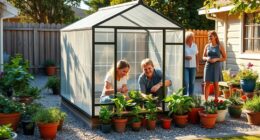To optimize greenhouse growth, you’ll want to implement advanced lighting schedules that adjust spectrum and photoperiods based on plant stages. Using programmable LED systems allows you to fine-tune blue, red, and other spectra to promote vegetative growth or flowering, while controlling light durations to mimic natural cycles. Focusing on energy efficiency while customizing light conditions can boost yields and plant health. Keep exploring these strategies to reveal even greater crop potential.
Key Takeaways
- Tailoring spectrum during growth stages enhances photosynthesis, flowering, and overall plant health.
- Using programmable automation optimizes light schedules, reducing human error and improving consistency.
- Combining spectrum control with photoperiod adjustments accelerates growth and maximizes yield quality.
- High-efficiency LED systems lower energy costs while providing precise, customizable light conditions.
- Integrating spectrum, timing, and automation creates an optimal environment for diverse crop requirements.

Lighting schedules and spectrum play a essential role in enhancing plant growth and health. When you understand how to tailor your lighting, you can markedly boost crop yields and improve plant vitality. One key aspect to contemplate is LED efficiency, which refers to how effectively your LED lights convert electricity into usable light for your plants. High-efficiency LEDs produce more light per watt, reducing energy costs while delivering the perfect spectrum needed for photosynthesis. This means you can maintain a strong light intensity without unnecessarily increasing your energy bills. Additionally, focusing on photoperiod optimization is indispensable. By carefully controlling the duration and timing of light exposure, you can mimic natural daylight cycles or create specific light patterns that encourage flowering, vegetative growth, or other desired plant responses. For instance, many plants respond best to a certain number of hours of light and darkness, so adjusting your schedule accordingly can accelerate growth and improve health.
Implementing an effective lighting schedule involves more than just turning on lights at random intervals. You need to develop a precise photoperiod plan tailored to your crop’s needs. For example, some plants require long-day conditions, meaning they thrive with extended light periods, while others prefer short-day cycles. By adjusting your lighting duration, you influence flowering and fruiting, ultimately affecting yield quality. LED efficiency plays a key part here, as you want to deliver the right spectrum during each phase of growth without wasting energy. During vegetative stages, a spectrum rich in blue light promotes strong, healthy foliage. When it’s time to flower, shifting to a spectrum with more red light encourages blooming. The ability to fine-tune spectrum and photoperiod allows you to optimize plant responses and maximize growth potential. Moreover, selecting vacuums for luxury vinyl plank floors that are gentle and non-abrasive can help maintain your flooring’s appearance, ensuring your workspace remains pristine.
Furthermore, the combination of LED efficiency and photoperiod optimization offers flexibility and precision. Modern LED systems often come with programmable controls, so you can automate your lighting schedule based on the specific growth stage. This automation helps maintain consistent light conditions, reducing human error and ensuring your plants receive exactly what they need when they need it. It’s important to monitor your plants regularly and adjust your schedule as they progress through different growth phases. By doing so, you guarantee your greenhouse environment remains perfect, energy consumption stays efficient, and your plants stay healthy. Ultimately, understanding and applying these advanced lighting strategies enable you to create a controlled environment where your crops thrive, yielding better quality and higher productivity.
Frequently Asked Questions
How Do Natural Outdoor Light Variations Affect Indoor Lighting Schedules?
Natural outdoor light variations, caused by weather fluctuations and seasonal changes, profoundly impact your indoor lighting schedules. You need to adjust your artificial lighting to compensate for shorter winter days or cloudy weather, ensuring plants receive consistent light. By monitoring outdoor conditions and modifying your schedules accordingly, you help optimize growth, prevent stress, and maintain a stable environment regardless of unpredictable weather or seasonal shifts.
Can Spectrum Adjustments Influence Plant Resistance to Pests and Diseases?
Spectral manipulation can boost plant resistance to pests and diseases by up to 30%. By adjusting the spectrum, you influence plant defenses and growth patterns. For example, increasing blue light enhances pest resistance, while red light promotes stronger immune responses. Implementing targeted spectral adjustments helps you create healthier, more resilient plants, reducing pesticide reliance and improving yields—making your greenhouse more sustainable and productive.
What Are the Energy Savings Associated With Advanced Lighting Strategies?
You can achieve significant energy savings with advanced lighting strategies by focusing on cost analysis and optimizing energy efficiency. Upgrading to LED systems and tailoring light spectra reduce electricity consumption and extend bulb life. These improvements lower operational costs over time while maintaining plant growth quality. By continuously analyzing energy use, you guarantee your greenhouse runs efficiently, saving money and reducing environmental impact through smarter lighting choices.
How Do Different Plant Species Respond to Specific Light Spectra?
Imagine a rainbow’s vibrant hues—each plant species responds uniquely to this spectrum. Your plants’ spectral sensitivity dictates their growth; for instance, leafy greens thrive under blue light, boosting photosynthesis, while flowering plants respond better to red spectra. Recognizing species-specific responses enables you to optimize lighting, fostering healthier growth and maximizing yield by tailoring light spectra to meet each plant’s unique needs.
Are There Automated Systems for Optimizing Lighting Schedules in Real-Time?
Yes, automated control systems exist that maximize lighting schedules in real time. You can implement these systems to monitor environmental conditions continuously and adjust lighting spectra and durations automatically. They use sensors and algorithms for real-time optimization, ensuring your plants get the ideal light conditions at all times. This technology enhances growth efficiency, reduces energy costs, and simplifies management, making it easier for you to maintain suitable greenhouse environments effortlessly.
Conclusion
By mastering lighting schedules and spectrum, you hold the key to revealing your greenhouse’s full potential. Think of it as orchestrating a symphony—each light and wavelength plays a crucial role in harmony. When you fine-tune these elements, you create an environment where plants thrive, grow faster, and yield better. So, take control, experiment, and let your greenhouse become a masterpiece of growth, powered by your strategic lighting choices.
